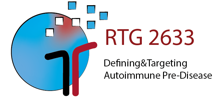Julia Wimmer-Gross
Testing the effect of kinase inhibitors in the human skin organ culture model for pemphigus foliaceus
Pemphigus foliaceus (PF) belongs to the autoimmune blistering diseases of the skin, also including the more prevalent type, pemphigus vulgaris (PV). Autoantibodies primarily target the desmosomal adhesion molecules desmoglein (dsg)1 and 3 and induce intraepithelial split formation. This process, known as acantholysis, clinically presents itself as vesicles and erosions in the epithelium of the skin and mucous membranes, leading to scaling and bleeding. In distinction stands PF, which has autoantibodies solely targeting dsg1, meaning only the skin is affected. Predilection sites are the seborrheic areas of the upper trunk, face and scalp, where puff-pastry like lesions occur due to subcorneal blisterformation.
Current therapeutic approaches involve high dose, systemic corticosteroids, immunoapheresis of circulating autoantibodies and intravenous administration of immunoglobulins, including the anti-CD20-antibody Rituximab. No targeted treatment is established yet. This project aims to asses wether PF has a similar pathomechanism as PV and to identify the role of kinases in it. The human skin organ culture model for PF imitates the formation of intraepidermal split by introducing a specific single-chain variable fragment (scFv). I aim to evaluate the effectiveness of kinase inhibitors in this particular HSOC model for PF.

- People
- Doctoral Candidates
- Merabell Adem
- Katja Adriany
- Farbod Bahreini
- Estelle Bergmann
- Swayanka Biswas
- Jana Buhre
- David De Luca Laredo
- Kaan Ersoy
- Ferdinand Gebauer
- Sen Guo
- Veronika Hartmann
- Michelle Hein
- Luise Janusch
- Maj Jäpel
- Anna Knauer
- Valentin Kneitz
- Maximilian Lahmer
- Wing Yu Lee
- Daniel Mehlberg
- Sahar Mehrabani
- Afsaneh Mehrpouyan
- Sadegh Mousavi
- Milica Novovic
- Justus Ohmes
- Bianca Opelka
- Colin Osterloh
- Cristian Papara
- Tina Rastegar Lari
- Rochi Saurabh
- Alessia Maria Sbaraglia
- Jovan Schanzenbacher
- Mareile Schlotfeldt
- Carolin Schmidt
- Solveig Lea Schmidt
- Leon Schmidt-Jiménez
- Nora Schoell
- Salomini Sinnathurai
- Sarah Stenger
- Chiara Walczyk
- Nele Wellbrock
- Julia Wimmer-Gross
- Natalia Zappe
- Jianrui Zheng
- Luca Zillikens
- Carla Zünkeler
- Principal Investigators
- Associated Scientists
- Administration
- Doctoral Candidates




